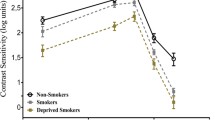Abstract
There is much evidence which indicates that smoking improves various aspects of human information processing (Wesnes 1987). The aim of the present study was to elucidate the stages of human information processing which are improved after cigarette smoking. Twelve regular smokers were tested on three cognitive tasks using a repeated measures design. Tasks used were: rapid visual information processing (RVIP), digit symbol substitution (DSST), and inspection time (IT). Performance parameters derived from these were intended to index different stages of the information processing sequence. Only those measures which involved a motor component were improved after smoking: response time on the RVIP task (P<0.025) and DSST performance (P<0.1). These findings suggest that central cholinergic pathways are involved in the late, response-related stages of the processing sequence.
Similar content being viewed by others
References
Broadbent DE (1984) Performance and its measurement. Br J Clin Pharm [Suppl] 1:5–11
Broks P, Preston GC, Traub M, Poppleton P, Ward C, Stahl SM (1988) Modelling dementia: effects of scopolamine on memory and attention. Neuropsychologia 26:685–700
Chiang A, Atkinson RC (1976) Individual differences and interrelationships among a set of cognitive skills. Memory and Cognition 4:661–672
Frankenhaeuser M, Myrsten AL, Post B, Johansson G (1971) Behavioural and physiological effects of cigarette smoking in a monotonous situation. Psychopharmacologia 22:1–7
Frearson W, Barrett P, Eysenck HJ (1988) Intelligence, reaction time and the effects of smoking. Person Individ Diff 9:497–518
Heimstra NW, Bancroft NR, DeKock AR (1967) Effects of smoking upon sustained performance in a simulated driving task. Ann NY Acad Sci 142:295–307
Hindmarch I, Stonier PD (eds) (1987) Human psychopharmacology: measures and methods, vol 1. Wiley, Chichester
Jensen AR (1987) Process differences and individual differences in some cognitive tasks. Intelligence 11:107–136
Kopelman MD (1987) How far could the cholinergic depletion account for the memory deficients of Alzheimer-type dementia or the alcoholic Korsakoff syndrome? In: Stahl SM, Iversen SD, Goodman EC (eds) Cognitive neurochemistry. Oxford University Press, Oxford, pp 303–326
Mangan GL, Golding J (1978) An “enhancement” model of smoking maintenance. In: Thornton RE (ed) Smoking behaviour: physiological and psychological influences. Churchill Livingston, Edinburgh, pp 87–114
Myrsten A, Post B, Frankenhaeuser M, Johansson G (1972) Changes in behavioural and physiological activation induced by cigarette smoking in habitual smokers. Psychopharmacologia: 27:305–312
Nettelbeck T (1987) Inspection time and intelligence. In: Vernon PA (ed) Speed of information processing and intelligence. Ablex, New Jersey, pp 295–346
Sanders AF (1983) Towards a model of stress and human performance. Acta Psychol 53:61–97
Taylor MM, Creelman CD (1967) PEST: efficient estimates on probability functions. J Acoust Soc Am 4:782–787
Vickers D, Smith PL (1986) The rationale for the inspection time index. Person Individ Diff 7:609–624
Vickers D, Nettelbeck T, Willson RJ (1972) Perceptual indices of performance: the measurement of “inspection time” and “noise” in the visual system. Perception 1:263–295
Warburton DM (1981) The neurochemistry of behaviour. Br Med Bull 37:121–125
Wechsler D (1955) Manual for the Wechsler Adult Intelligence Scale (WAIS). Psychological Corporation, New York
Wesnes K (1987) Nicotine increases mental efficiency: but how? In: Martin RW, Van Loon GR, Iwamoto ET, Davis L (eds) Tobacco smoking and nicotine: a neurobiological approach. Plenum Press, New York, pp 63–80
Wesnes K, Warburton DM (1983) The effect of smoking on rapid visual information processing performance. Neuropsychobiology 9:223–229
Wesnes K, Warburton DM (1984a) Effects of cigarettes of varying yield on rapid visual information processing performance. Psychopharmacology 82:338–342
Wesnes K, Warburton DM (1984b) Effects of scopolamine and nicotine on human rapid information processing performance. Psychopharmacology 82:147–150
Wesnes K, Warburton DM, Matz B (1983) The effects of nicotine on stimulus sensitivity and response bias in a visual vigilance task. Neuropsychobiology 9:41–44
Williams DG (1980) Effects of cigarette smoking on immediate memory and performance in different kinds of smokers. Br J Psychol 71:83–90
Wittenborn JR (1987) Psychomotor tests in psychopharmacology. In: Hindmarch I, Stonier PD (eds) Human psychopharmacology: measures and methods, vol 1. Wiley, Chichester
Zhang Y, Caryl PG, Deary IJ (1989) Evoked potential correlates of inspection time. Person Individ Diff 10:379–384
Author information
Authors and Affiliations
Rights and permissions
About this article
Cite this article
Petrie, R.X.A., Deary, I.J. Smoking and human information processing. Psychopharmacology 99, 393–396 (1989). https://doi.org/10.1007/BF00445565
Received:
Accepted:
Issue Date:
DOI: https://doi.org/10.1007/BF00445565




